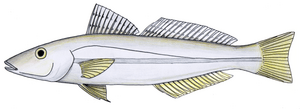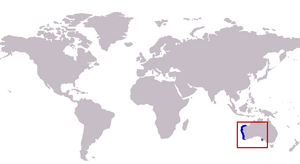Yellowfin whiting facts for kids
Quick facts for kids Yellowfin whiting |
|
|---|---|
 |
|
| Scientific classification | |
 |
|
| Range of the yellowfin whiting | |
| Synonyms | |
|
The yellowfin whiting (Sillago schomburgkii) is a type of fish that lives near the coast. It is also known as the western sand whiting or fine-scaled whiting. This fish belongs to the smelt-whiting family, called Sillaginidae.
Yellowfin whiting are found only in the eastern Indian Ocean, off the coast of Australia. They live in shallow waters, often in tidal flats, creeks, and large estuaries. These fish can grow quite large, up to 42 centimeters (about 16.5 inches) long. They eat small creatures living on the seafloor, mostly worms. Yellowfin whiting are important for fishing in Australia and are popular with people who like to fish. They are also considered a very tasty fish to eat.
Contents
How the Yellowfin Whiting Got Its Name
Scientists group living things into families and species. The yellowfin whiting is one of 29 species in the Sillago group. This group is part of the smelt-whiting family, Sillaginidae.
The yellowfin whiting was first officially described by a German scientist named Wilhelm Peters in 1864. He found a sample of the fish near Adelaide, South Australia. Peters named the fish schomburgkii to honor Moritz Richard Schomburgk. Schomburgk was a German explorer and botanist who sent the fish sample to Peters.
Before Peters named it, some people confused this fish with a similar one called Sillago bassensis. The yellowfin whiting was also given other names later, like Sillago bostockii and Sillago frazeri. However, these names are not used anymore because Peters' name was the first one.
The fish is mostly called 'yellowfin whiting' because of its yellow fins. In Western Australia, people often call it the 'western sand whiting'. This is because it looks a lot like the sand whiting found in Eastern Australia.
What Does the Yellowfin Whiting Look Like?
The yellowfin whiting looks similar to other whiting fish in Australia. You can tell it apart by its colors and the shape of its swimbladder (an air-filled sac that helps fish float). It is one of the biggest fish in its family, growing up to 42 cm (16.5 inches) long and weighing up to 860 grams (about 1.9 pounds).
Its body is long and a bit flat. It has a small mouth with many tiny teeth. The fish has two dorsal fins (on its back). The first dorsal fin has 10 to 12 stiff spines, and the second has one spine and 19 to 22 soft rays. The anal fin (on its belly) has 2 spines and 17 to 20 soft rays. Its other fins, like the ventral and pectoral fins, also have spines and rays. The tail fin is slightly notched.
The body is covered in small, rough scales. These scales even extend to its head. The fish has a line of scales along its side called the lateral line, with 66 to 76 scales. It also has 37 vertebrae (backbones).
The yellowfin whiting is usually sandy brown or pale silvery-grey. Its back is darker, and its belly is lighter. It might have a thin silver band along its side. The dorsal fins are clear with small brown spots. The anal and ventral fins are pale yellow, but this yellow color can fade as the fish gets older. The pectoral fins are also pale yellow or clear, without a dark spot. The tail fin is greyish.
Where Yellowfin Whiting Live
Yellowfin whiting live only in the waters off southwestern Australia in the Indian Ocean. Scientists believe there are two separate groups of these fish. One group lives in Western Australia, and the other lives in South Australia.
The western group is found from Dampier down to Albany. The southern group lives in Spencer Gulf and Gulf St Vincent, extending east to the Fleurieu Peninsula. Studies have shown that the fish in each of South Australia's Gulfs stay separate from each other.
These fish mostly live in shallow, protected waters close to shore, usually less than 10 meters (33 feet) deep. You can often find them on sand flats, mud flats, and in mangrove-lined creeks. They also live in seagrass beds and estuaries.
Yellowfin whiting move with the tide. When the tide comes in, they swim into the shallow parts of creeks and flats to find food. As the tide goes out, they move back to deeper channels. In Western Australia, they can enter large estuaries like the Swan River. They can even live in brackish water, which is a mix of fresh and salt water. They can also survive in very salty waters, like those in upper Spencer Gulf and Shark Bay. This shows they can handle many different salt levels. Young fish live in the same places as adults in South Australia. But in Western Australia, adult fish move from tidal creeks to sandy beaches.
Yellowfin Whiting Life and Habits
Yellowfin whiting are fish that swim in schools. Their movements depend a lot on the tides. They often move over shallow sand banks when the tide rises. Unlike some other whiting species, yellowfin whiting stay in shallow, protected waters as they grow. This helps them avoid competing for food and space with other fish.
Scientists have studied what yellowfin whiting eat and how they reproduce. This is because they are a big part of the fishing industry. Like some other whiting, they can "burrow" into the sand to hide from predators.
Diet and Feeding Habits
The yellowfin whiting is a benthic predator. This means it hunts for food on the bottom of the ocean. It uses its good eyesight and a mouth that can stick out to "suck up" prey from the seafloor.
Studies in Western Australia show that these fish mainly eat polychaete worms. They also eat a lot of crustaceans, like amphipods and prawns. Sometimes, they eat small fish, bivalve shells, and marine plants. The energy for these fish often comes from seagrass and algae, which are eaten by the small creatures the whiting then eats.
As yellowfin whiting grow, their diet changes. Young fish, less than 10 cm (4 inches) long, eat many small crustaceans called copepods. Once they reach about 10 cm, they start eating mostly worms. As they get even bigger, they eat more amphipods and small fish. This change happens because the fish can move more and have bigger mouths to catch different prey.
Their diet also changes depending on the place and time of year. This is because different prey are available at different times. When young, yellowfin whiting share food with other whiting species in shallow areas. But as they grow, they stay in shallow waters while others move to deeper areas. This helps them avoid competing for food.
Reproduction and Life Cycle
Yellowfin whiting become ready to reproduce when they are about 20 cm (8 inches) long for males and 23 cm (9 inches) for females. Most fish reach this size by the end of their second year.
The time when they lay eggs (spawn) changes depending on where they live. In Shark Bay, spawning happens between August and December. Further south in Western Australia and in South Australia, it happens between December and February. Before spawning, the fish move into shallow areas like estuaries. Then, groups of fish break off from the main school to lay their eggs.
Female yellowfin whiting can release between 170,000 and 217,000 eggs each season. These eggs float in the water and are very small, about 0.6 mm wide. When the larvae (baby fish) hatch, they are very tiny. By the time they are 2.7 mm long, they can eat, see, and have a working swimbladder.
Young fish appear in Western Australian estuaries around March. They grow quite fast. However, yellowfin whiting grow slower than some other whiting species, but they reach a much larger size. On average, they are about 8 cm (3 inches) long after their first year. By the end of their second year, they are about 24 cm (9.5 inches). Females tend to grow a bit faster than males. The oldest yellowfin whiting found was a 12-year-old female that was 35 cm (13.8 inches) long.
Yellowfin Whiting and People
Yellowfin whiting are highly valued as a table fish (fish to eat). Many people think they taste great, though some say the King George whiting is even better. Because they are popular and common, yellowfin whiting are a big target for both commercial fishermen and people who fish for fun.
Commercial Fishing for Yellowfin Whiting
There are two main areas where yellowfin whiting are caught for sale: the Gulfs of South Australia and Shark Bay in Western Australia. There are also smaller fishing areas in Western Australia, like the Blackwood River estuary.
Fishermen use different methods to catch them, including large nets like beach seines and gill nets. Nets are often set in the mornings in South Australia, when fish move from shallow areas back into deeper channels. In the past, these fisheries caught a lot of fish. For example, in Shark Bay, the most fish ever caught in one year was 204 tonnes in 1961. Today, catches in Shark Bay are around 100 to 130 tonnes per year. In South Australia, catches have recovered to about 150–170 tonnes per year after a drop in the late 1980s.
Fishing for Fun
Yellowfin whiting are a very popular fish for people who enjoy recreational fishermen. People like them because they are good to eat, provide a fun challenge on light fishing lines, and can be caught easily from beaches and jetties. You don't even need a boat to catch them.
Anglers often fish for yellowfin whiting from beaches, estuaries, and jetties in shallow waters. The best times to catch them are when the tide is coming in or going out. Since these fish can be easily scared, fishermen usually use very light fishing gear. This means thin lines (under 6 kg), small hooks (size 4 or smaller), and very light sinkers. Heavy lines or sinkers can scare the fish away.
Some whiting fishermen put a red bead or tube just above the hook to attract the fish, but people debate if this really helps. The most common bait used is 'beach worms'. Prawns, cockles, and squid can also work well. It's not common to catch them with lures or by fly fishing because they are shy.
Sometimes, more yellowfin whiting are caught by recreational fishermen than by commercial ones. For example, in the Blackwood River, anglers caught 120,700 fish in one year. In South Australia, recreational fishermen caught 28% of all yellowfin whiting in 2000/2001, which was over 50 tonnes of fish. To protect the fish, rules have been put in place. In South Australia, you can only keep fish that are at least 24 cm (9.5 inches) long, and you can only catch 20 fish per day. In Western Australia, there is no minimum size, but you can catch a total of 40 whiting, including other types of whiting.
See also
 In Spanish: Sillago schomburgkii para niños
In Spanish: Sillago schomburgkii para niños

